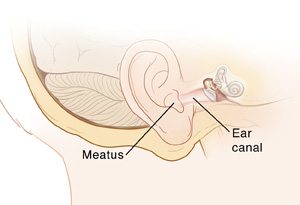Meatoplasty (Ear)
Meatoplasty is a type of ear surgery. It's done on the opening into the ear canal (meatus). The surgery may be needed to widen the opening. Or it may be needed to help the meatus line up better with the ear canal. This helps keep the ear canal from getting blocked with wax and debris. It also helps reduce the risk of ear infections.

How to say it
mee-AT-oh-plas-tee
Preparing for surgery
Prepare for the procedure as you have been directed. Be sure to tell your healthcare provider about all medicines you take. This includes over-the-counter medicines. It also includes vitamins, herbs, and other supplements. You may need to stop taking some or all of them before surgery as directed by your healthcare provider. Also tell your healthcare provider about allergies you have. Follow any directions you’re given for not eating or drinking before surgery.
The day of surgery
The surgery takes about 1 to 2 hours. You’ll likely go home on the same day. Before the surgery begins:
-
An IV (intravenous) line is put into a vein in your arm or hand. This line supplies fluids and medicines.
-
You’ll be given medicine (anesthesia) to keep you free of pain during the surgery. You may be given general anesthesia. This allows you to comfortably sleep during the surgery. Another choice may be to give you sedation, which makes you relaxed and sleepy. In this case, local anesthesia is used to numb the area being worked on.
During the surgery
Here is what to expect during the surgery:
-
Incisions are made in and around the ear canal. Then tissue is removed or rearranged to make the ear opening larger.
-
The ear canal is filled with antibiotic ointment or fluid. This helps prevent infection. A special kind of dressing (packing) may also be placed in the ear canal.
After the surgery
You’ll be taken to a the PACU (postanesthesia care unit) to be checked on as you wake up from the anesthesia. You’ll be given medicines to manage pain and prevent infection. If you have packing inside the ear canal, you may have trouble hearing out of that ear. This is not a sign of a problem. Be aware that you may have some dizziness after the surgery. This can last for a few days. When it’s time for you to be released from the hospital, have an adult caretaker ready to drive you.
Recovering at home
Once at home, follow any special directions you are given. Make sure to:
-
Take all medicines as directed. These may include eardrops and ear ointment.
-
Care for your incision and packing as directed.
-
Place a clean cotton ball dabbed with a small amount of petroleum jelly in the outer ear before you bathe or shower. This helps keep your ear dry. Remove the cotton ball when you’re done bathing or showering.
-
Don't drive, climb stairs, or stand on ladders until any dizziness has passed.
-
Don't do any heavy lifting or strenuous activities for at least 2 weeks or as directed by your provider.
-
Don't swim, fly in a plane, or travel in the mountains until your healthcare provider says it’s OK.
When to call your healthcare provider
Be sure you have a contact number for your healthcare provider. After you get home, call your provider right away if any of the following occur:
-
Chest pain or trouble breathing (call 911)
-
Fever of 100.4° F ( 38° C) or higher, or as directed by your healthcare provider
-
Bright red bleeding or foul-smelling drainage from your ear (some pink-tinged drainage is normal)
-
Increased redness or swelling around the ear
-
Dizziness, nausea, or vomiting that gets worse
-
Pain that can't be controlled with medicines
Follow-up
During follow-up visits, your healthcare provider will check your healing. If your stitches or packing need to be removed, this may be done in about 7 to 10 days.
Risks and possible complications
Risks of this procedure include:
-
Bleeding or a collection of blood under the skin (hematoma)
-
Infection
-
Dizziness
-
Ringing in the ear
-
Scarring and other healing problems (these may need more surgery to repair)
-
Narrowing of the opening to the ear canal
-
Risks of anesthesia